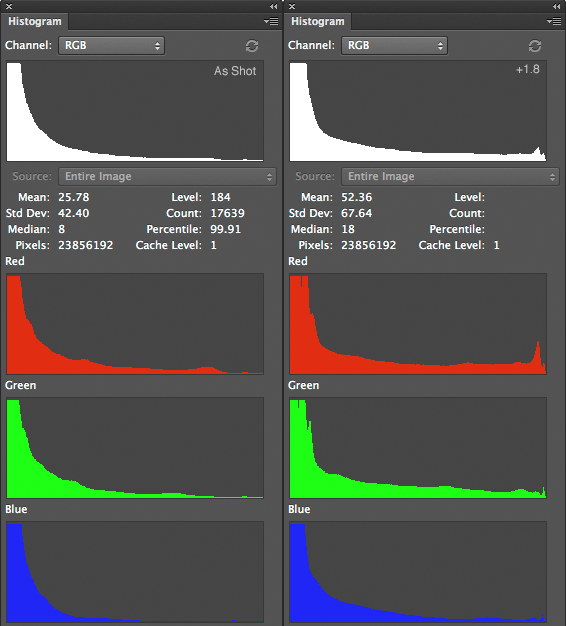Leica M Typ 240 / M240 Image Quality
I don’t yet have the new Leica M Typ 240 which on paper looks to be the camera for Leica M shooters that solves the focusing accuracy problem for those with less than perfect vision, and also the rangefinder compositional challenges (crude framing) of the M9.
However, after I downloaded the “performance proofs”, I now have concerns about the image quality with the new sensor at its base ISO of 200.
From what I see just using my eyes, the “performance proofs” seem to be proofs of something else than what is supposed.
In general, it’s not clear to me that the CMOS sensor has the brilliance of the CCD in the M9, one really appealing characteristic of the M9/M9P. But this is just a subjective impression based on too-few images. At least one of the “proofs” is misfocused enough that I’d have immediately discarded it.
ISO 200 “proof”
Let’s examine the quality of LeicaM_ISO200_135mm_f3,4.DNG (food image). Readers can download this “performance proof” image (Leica’s term) from the Leica web site.
I’m not going to assume that I can display this image here (copyright), but its histogram is fair game. The image is of a tomatoes, a loaf of bread, a bottle of olive oil and a wine glass with strong side lighting.
The food image was shot at ISO 200. It has a near-black background along with high-key elements. Hence exposure is critical, and it’s clear it was not well done in an ETTR sense, being somewhere around two stops less exposure than ideal (by ETTR standards). If not two stops, then call it 1.5 stops.
I prefer a brighter rendition than as-shot, but for the purposes of seeing shadow detail I settled on a +1.8 push. That amount of push is routine for opening up shadows. In the real world, a 2-stop push is something one might do (selectively) to open up dark areas in shadows in (for example) a landscape shot. And a 1-stop push is routine since cameras often underexpose by that amount.
Let me be clear that the as-shot exposure looks great overall; the darks are so dark as to hide any issues there. But the question is what happens in real-world use when one needs to pull up dark areas in brightness, or simply when the image is underexposed.
The histograms shown below are for the as-shot (+0) conversion and +1.8 conversions using Adobe Camera Raw into 16-bit ProPhotoRGB. Observe that the +1.8 conversion is on the bright side, but it is not blown out other than a few very small areas, and only in the blue channel. In short, +1.8 is a perfectly reasonable exposure on a histogram basis.
With the +1.8 push, we can see some unpleasant things develop in the dark background:
- Hot (bright) pixels by the hundreds or more.
- Pronounced pattern (stripes) and cross-hatch noise most noticeable in the red and blue channels.
Actually, the hot pixels and pattern noise are visible even without the push, at least with a calibrated display and proper viewing conditions. And with a +1 push (a brightness I prefer for the finished image), bad things are readily visible.
I thought this kind of hot pixel and pattern noise was only a bad memory from half a decade ago, but the Leica M Typ 240 has yet to ship here in 2013.
The mitigating factor is that the background is very dark. But that’s often the case with real world photography, whether it be landscapes or dramatic lighting or street shooting.
Really dark tones will always have some noise, but this M240 behavior waves a big red flag for me. I will be on the lookout for noise behavior when I get my hands on the M240.
Jonathan Slack (photographer who made the image) writes:
Whether shots from this very early iteration of the camera should have been used is a moot point (and I'd certainly not been aware of the issues here).
But it is worth mentioning that this WAS a very early iteration, and the sensor was not properly calibrated with respect to bright pixels (there is actually a line of defective pixels to the right side).
It is my position that if Leica decides to post images from an early version of the M240, especially “performance proofs”, then Leica ought to provide information deemed relevant together with the images . Since Leica did not do so, the only reasonable approach is to take Leica at their words: “performance proofs”.
Leica provided an M240 to Mr. Slack months before shipping, then chose to post resulting images as-is without commentary on pre-production quality. At best, this seems ill-considered. Here we have a company unsure of when it it can deliver new products (witness the delays on both the 50/2 APO ASPH and M240) and apparently unaware of the significance of posting impaired “performance proofs” on the web.
Is the image quality substantively improved in later versions of the camera? I’d be delighted to see that occur. But whether the M240 sensor will be as clean as the latest Nikon and Sony or even Canon sensors seems dubious. Those companies have year and years of CMOS manufacturing experience together with the image processing algorithms and electronics needed to produce a finished RAW image.

LeicaM_ISO200_135mm_f3,4-1.DNG

























